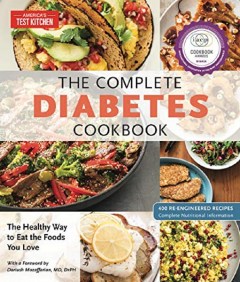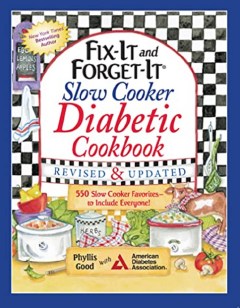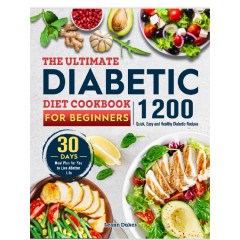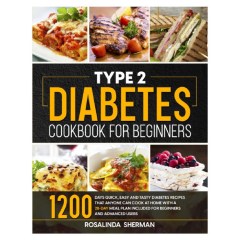BestReviews is reader-supported and may earn an affiliate commission. Details

Featuring 90 recipes and strategies for cooking your own meals with proteins, non-starchy vegetables, and grains, the best option for beginners.
Featuring 90 recipes and strategies for cooking your own meals with proteins, non-starchy vegetables, and grains, the best option for beginners.
Image-packed guide for creating simple, healthy, and delectable diabetic-friendly meals. Examples include lamb chops, onion, and beet soup, and balsamic roasted chicken.
Some recipes require quite a few ingredients.

Vibrant photos, simple instructions, and both nutritious and appetizing diabetic-centric meals make it the must-have diabetic cookbook.
Vibrant photos, simple instructions, and both nutritious and appetizing diabetic-centric meals make it the must-have diabetic cookbook.
Over 400 diabetes-friendly recipes for a truly impressive range of great foods. Taste-tested. Examples include fried eggs, shrimp skewers, and Italian meatball soup.
A little pricy, but it’s a beefy book of recipes.

With its huge series of near-effortless recipes and handy dietary tips, it’s the ultimate cookbook for diabetics who own a slow cooker.
With its huge series of near-effortless recipes and handy dietary tips, it’s the ultimate cookbook for diabetics who own a slow cooker.
A whopping 550 diabetic-friendly recipes made easy with a slow cooker. Examples include beef stew, venison stew, and Asian pepper steak. Details how to use a meal plan.
Not too helpful if you don’t have a slow cooker.

More than 1,200 healthy recipes for dinner, dessert, and more; complete with a 30-day meal plan to help you learn better diet habits.
More than 1,200 healthy recipes for dinner, dessert, and more; complete with a 30-day meal plan to help you learn better diet habits.
Written with a wide range of diabetic patients with a variety of unique dietary needs in mind. The recipes are easy for beginners. There's a meal plan to set things off and hundreds more recipes to explore when you're done.
Those with atypical dietary needs may want to look closer before they buy.

There are more than 1,200 healthy recipes for dinner, dessert, snacks, and more in this easy-to-follow cookbook for any expertise.
There are more than 1,200 healthy recipes for dinner, dessert, snacks, and more in this easy-to-follow cookbook for any expertise.
It includes a 28-day meal plan to get you going in the right direction. The recipes are designed for the unique needs of type 2 diabetes patients. They chose affordable recipes on purpose.
There aren't any pictures for guidance.

We recommend these products based on an intensive research process that's designed to cut through the noise and find the top products in this space. Guided by experts, we spend hours looking into the factors that matter, to bring you these selections.

While many people's health would improve with a more balanced diet, when you have diabetes, positive dietary decisions need to be more than wishful thinking. Diabetic cookbooks simplify meal planning for individuals who live with diabetes. They allow home cooks to focus on cooking instead of research. These compilations put tried-and-true recipes at your fingertips, so there’s less temptation to stray.
Diabetes is a condition that impacts the way the body metabolizes sugars, which take different forms, but all leave too much glucose in the blood. Over time, this excess sugar damages blood vessels and causes other complications. It’s common to manage diabetes with insulin injections, to make up for what the pancreas doesn’t produce. Additionally, many people choose to lower their blood sugar through exercise and diet, with the help of a diabetic cookbook.

Do you know the difference between a sauté and a soufflé? What about a paring knife and a carving knife? If not, it might be wise to shop for a cookbook with simple recipes. Look for titles including keywords like “easy,” “quick,” “five-ingredient” or similar terms. Beginning cooks have enough of a learning curve. It’s unrealistic to expect them to get a handle on diabetes and master complex points of food preparation at the same time.
Advanced cooks, on the other hand, may be used to more complex flavors and find simpler recipes too bland. Those who have mastered the basics are better prepared to make more challenging dishes. Enjoying intriguing flavors and textures may help you stick to your diet, too.
Do you typically dine alone or set a table for two? Does your dish need to feed a whole family? Preparing large, diabetic-friendly meals can be challenging, since budget-stretching, starchy ingredients like potatoes, bread, and rice are largely off-limits. Cookbooks that teach the tricks of the trade in this area are worth their weight in gold.
Electric pressure cookers have taken the world by storm in recent years. Others say they can’t live without their slow cooker, air fryer, or other time-saving kitchen gadgets. If you have a tool you already love, it makes sense to look for a cookbook that’s compatible rather than starting over. Trying to master a new device and a new diet may feel too overwhelming.
New popular diets emerge every year. Most target quick weight loss rather than health goals, but they can still be powerful tools in the type 2 diabetic’s arsenal. Your pancreas is better able to keep up with your body’s insulin needs as your weight drops. Some individuals lose enough weight to keep their blood sugar levels regulated without insulin. If you go this route, make sure you pick a diet you can live with. Putting weight back on reverses your progress and wastes all your hard work. It’s wise to consult your doctor before making any major dietary changes, but some popular diet options include the following:
Paleo: The paleo diet is low in carbohydrates and eliminates modern processed foods, so many dieters experience weight loss. Lean meats, fruits, vegetables, and nuts are staples of this diet, which claims to return to foods humans would have consumed during the Paleolithic, or early Stone Age. Some experts say the paleo diet is good for diabetics; others say it’s a neutral option.
Keto: The keto diet is also low carb, so it may be good for cutting blood sugar levels. Many adherents believe the diet affects how the body uses and stores energy. However, the ketogenic diet does involve high consumption of heart-healthy fats, which presents other risks.
Whole30: Most consider Whole30 to be more of a dietary reset than a long-term eating plan. Many lose weight and lower their blood sugar levels on this diet, which eliminates foods like dairy, legumes, and grains. Whole30 includes foods that can help diabetics and teach them to pay attention to their diet and their body’s reactions, but it’s highly restrictive and cuts out some food groups beneficial to diabetics.

Today, cookbooks are available in more formats than ever. The best format is the one you’ll use, so pick whichever is most practical for your lifestyle.
Paperbacks: These typically aren’t expensive, so they’re a budget-friendly option if you’re lukewarm on the contents. Most don’t stay open on a kitchen counter long without bending, and they’re vulnerable to drips and spills.
Hardcovers: These cookbooks stay open more easily on a counter than their paperback counterparts, but their pages are just as vulnerable to spattering sauces.
Spiral-bound: These cookbooks are pricier, but they’re worth the investment for a volume you know you’ll love. They usually stay open more easily on a counter, so you’re not constantly fighting to find your recipe. Most have reinforced, plasticized pages, so they hold up better to kitchen accidents.
Electronic: These cookbooks are often cheaper than any other option because they don’t require any material resources from the publisher. They’re extremely portable, making it easier to stick to your diet when you travel. But it’s easy to lose your place if you’re toggling between screens, and use requires your device to be charged.
Foods: Embracing a diabetic-friendly diet is a big change, but that doesn’t mean you have to ditch all your favorites foods. Many cookbooks offer low-sugar, low-carb twists on comfort foods, classic holiday favorites, exotic Asian flavors, and more. It’s good to branch out, but too much change all at once can leave you discouraged and throw you off track.
Meals: Many cookbooks focus on dinner, but there are three meals in the day. Many find breakfast, with its carb-laden cereals and pastries, to be the biggest challenge. Many dieticians say breakfast is the most important meal of the day, so don’t ignore it — or lunch either.
Pictures can make or break a cookbook. Often, it’s the intriguing illustrations that catch our attention instead of the black-and-white ingredients list. If you’re highly visual, or you need a little extra motivation, look for quality books with artistic illustrations that help you picture the end product of your work.
Inexpensive: You can get quality diabetic cookbooks full of tried-and true recipes starting between $8 and $15. In this price range, you’ll find both paperback books and electronic compilations of diabetes-friendly recipes. Most, if not all, recipes focus on dinner.
Mid-range: The next tier of diabetic cookbooks runs $15 to $20. Paperbacks and hardcovers can be found in this price range, but most are spiral-bound. These books should include a couple hundred recipes, with more options for meals other than dinner.
Expensive: The priciest diabetic cookbooks cost $20 to $30. If you’re paying this much, you should be getting a weighty, spiral-bound tome. It should have hundreds of well-illustrated recipes that fit the bill for breakfast, lunch, and dinner.


Q. Are diabetic cookbooks for type 1 or type 2 diabetes?
A. A diabetic-friendly diet can benefit both. Type 1 diabetes, often diagnosed during childhood, can’t be managed by diet alone, since the pancreas chronically produces little to no insulin. Dietary choices can’t reverse type 1 diabetes, but they can still impact your health. Type 2 diabetes occurs when the body doesn’t produce enough insulin to metabolize sugar. While blood vessel damage from type 2 diabetes can’t be undone, it’s possible to achieve normal blood sugar levels by dietary means through ongoing, consistent effort.
Q. What foods should people with diabetes avoid?
A. Refined foods like white bread, pasta, white rice, and many breakfast cereals can wreak havoc on a diabetic’s blood sugar levels. Even more natural options like potatoes, dried fruit, and fruit juice are generally off-limits. You should skip sugary sodas and flavored caffeinated drinks, too. Other limitations are harder to define. Diabetic cookbooks do the hard work for you, so that you can make the most of your time cooking rather than researching the ins and outs of each ingredient.
Q. My doctor says I have prediabetes. Can a cookbook help?
A. Yes! Changes to your lifestyle can keep your condition from turning into diabetes. Eating meals like those included in a diabetic cookbook, as well as exercising regularly, are excellent ways to ward off the disease. Prediabetes doesn’t have any symptoms, but you may be at risk if you have an immediate relative with diabetes, if you’re overweight, if you have high blood pressure, or if you are female and have been diagnosed with polycystic ovary syndrome.
Get emails you’ll love.
Learn about the products you’re wondering if you should buy and get advice on using your latest purchases.
